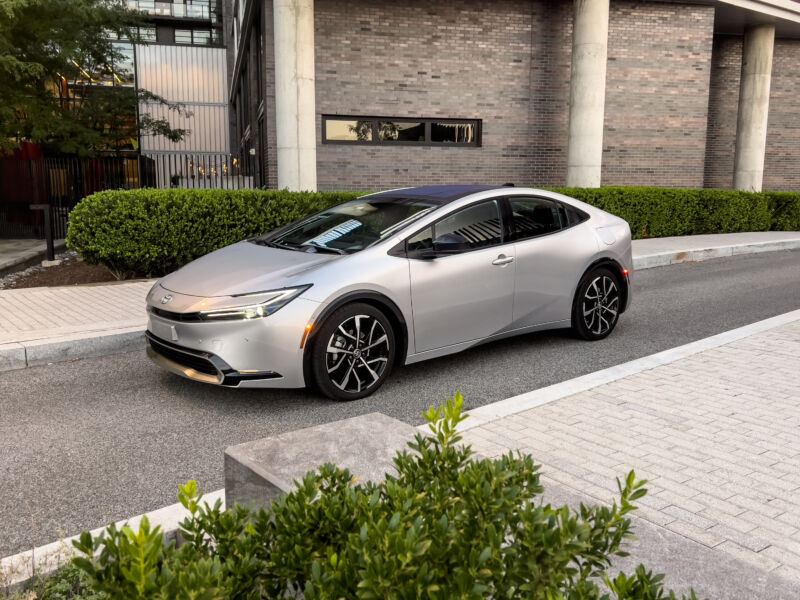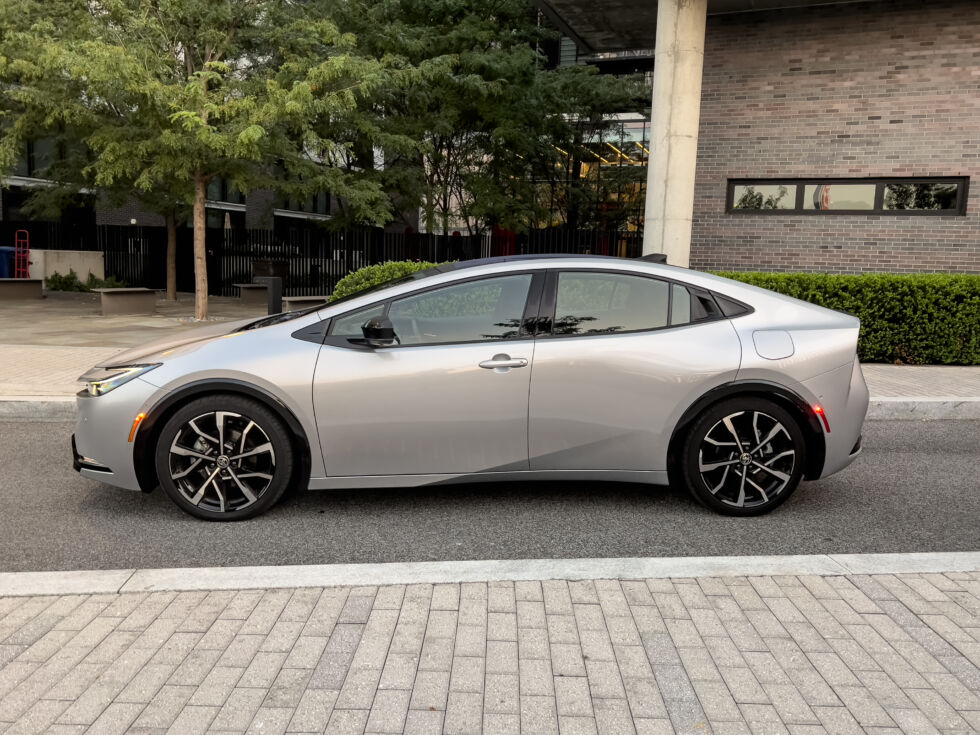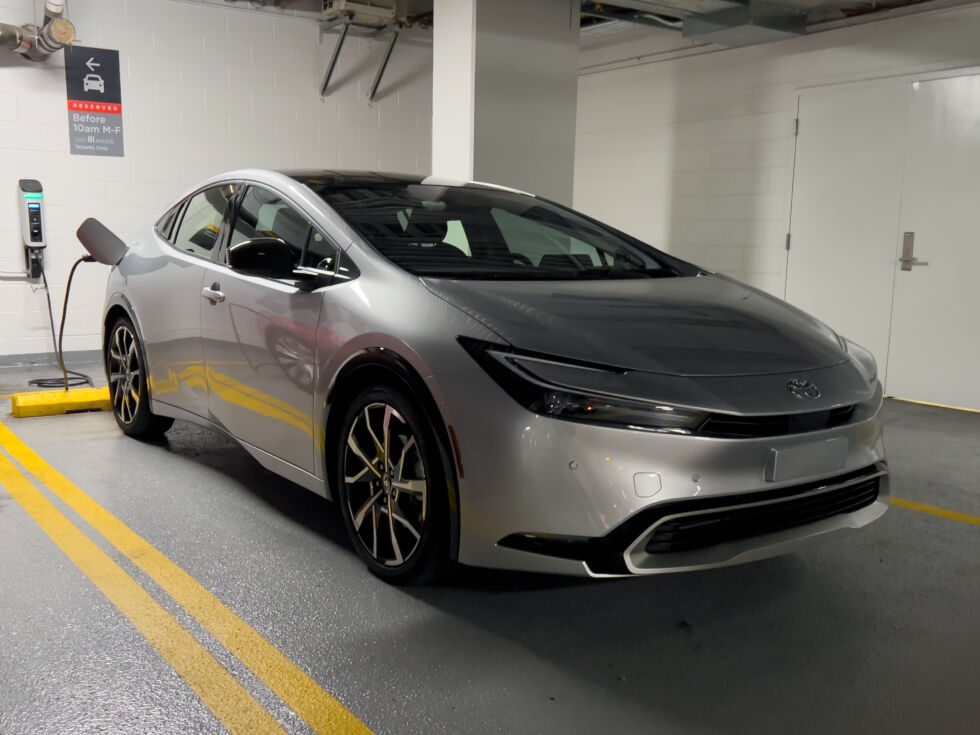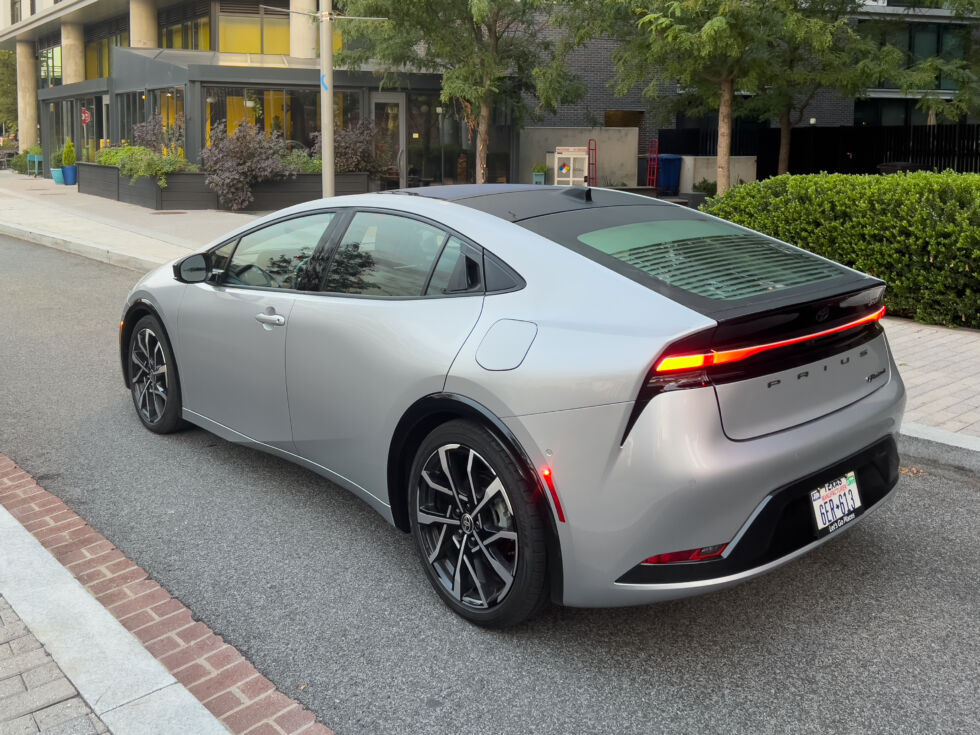
Earlier this year, we spent some time with the new Toyota Prius. There was a lot to like about the new car, the fifth to bear its name—sleek looks and minimal fuel consumption are the highlights. Today, it's Prius Prime, the plug-in hybrid variant. Toyota might have been early to hybrids and uncomfortably late to battery-electric vehicles, but the Prius Prime straddles the line between the two, offering a battery big enough for most daily driving and a highly efficient gas-burning powertrain for longer journeys.
Much of what I wrote about the not-Prime Prius applies to the plug-in, too. There are the same sleek looks, with a steeply raked windshield and a far more cohesive design than the model it replaced—that one looked like the result of two separate car designs that were later crashed into each other. I'm starting to think that the car needs a front license plate to look right—that little bump out on the fascia where a plate is supposed to attach looks rather obvious in the case of our Virginia-registered tester.
The $39,170 Prius Prime XSE Premium we tested doesn't look quite as racy as the blue car we had in May—mostly, that's down to the different design of the alloy wheels. Smaller 17-inch wheels with aerodynamic covers are available with the Prius Prime SE ($32,350), but like the XSE Premium, the mid-range XSE ($35,600) also rides on the bigger 19-inch wheels. I mention this upfront because if you're looking for the most efficient option, the stripped-out base model on small wheels has a lower drag coefficient and runs more economically.

It's a matter of degrees, though; whichever Prius Prime you pick will be efficient. Under the hood lives a 2.0 L Atkinson cycle gasoline engine that generates 150 hp (111 kW) and 139 lb-ft (188 Nm)—identical to the engine that powers the cheaper Prius that doesn't plug in to recharge.
The hybrid electric motor-generator is more powerful for the plug-in Prime, however. This generates 161 hp (120 kW), with a combined maximum output from both motor and engine of 220 hp (164 kW). There's now a 13.6 kWh lithium-ion traction battery that feeds the electric motor, a large increase from the 8.8 kWh pack in the previous-generation Prius Prime plug-in hybrid, although only 10.9 kWh is useable.
It takes about four hours to charge the battery if you have access to 240 V level 2 charger, or 11 hours on a normal 120 V outlet, and via regenerative braking. But unlike some other plug-in hybrids we've tested, there's no mode to recharge the battery by drawing power from the internal combustion engine.

Toyota says the Prius Prime SE should have up to 44 miles (70 km) of range on the battery alone in EV mode and 39 miles for the larger-wheeled XSEs. With a full charge, the onboard computer told me we had a range of 35 miles, and operating on electric power alone, I averaged an easy 3.5 miles/kWh (17.8 kWh/100 km) in EV mode.
I rather enjoyed the Prius as an EV for city driving—as noted in the earlier not-Prime review, in order not to obscure the rather small main instrument display with the rim of the steering wheel, you might need to adjust the wheel so it's low down in your lap, which encourages a more relaxed attitude than if you were hunched up at the controls like a rally driver. You can increase the regenerative braking that occurs when you lift the throttle by engaging B instead of D with the stubby little shift lever, and even in D, there's enough regen on lift-off that you won't coast for very long.
There's a hybrid/EV auto mode that juggles where and when to fire up the Prius' gasoline engine—annoyingly, I discovered that shifting from this mode back to EV often left the engine still running, which is a bug Toyota might want to look at.

Once you've used up the 10.9 kWh of available energy in the battery pack, the Prius Prime will switch to hybrid mode. Here, it operates just like the normal Prius, and there's always some of the battery pack reserved for this mode. I was surprised by the efficiency—the onboard computer told me I averaged 52 mpg (4.52 L/100 km), which is not just impressive but also exceeds the EPA combined rating of 48 mpg (4.9 L/100 km) for the XSE and XSE Premium. (The Prius Prime SE is rated at 52 mpg combined, but we definitely didn't have the cheaper version as our test car.)
With more time in a 2023 Prius, I've come to a few conclusions about the interior beyond that laid-back driving position that, together with the multifunction steering wheel, reminds me of early 1980s Citroen concept cars like the Xenia or Karin. For one, I don't love the multifunction wheel, though it scores points over some other OEMs by sticking with physical buttons rather than joining the capacitive touch revolution. The large 12.3-inch infotainment system is acceptable and includes wireless Apple CarPlay and Android Auto, as does the 8-inch version that's standard in the SE and XSE Prius Primes.

I'm definitely not a fan of the maroon-ish highlight panel in the dash, and the JBL-branded tweeters on the A pillar look and sound a little cheap. But I do like the little beeps and chimes it makes—these are common across most current Toyotas, and I still maintain that putting it into reverse results in the car playing the opening notes to the Sesame Street theme.
In all, I'm still a bit smitten with the 2023 Prius, and that extends to the plug-in Prius Prime.
Promoted Comments